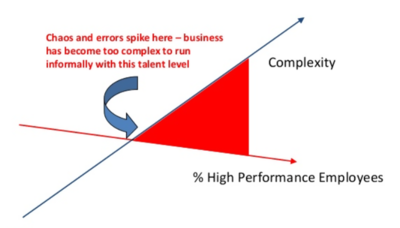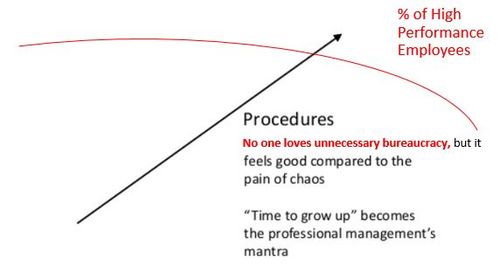Operations and Roles
It's common for companies to curtail freedom and become more bureaucratic as they grow. First, because the desire for a bigger positive impact creates growth naturally. Growth, on the other hand, increases complexity and often shrink talent diversity because some people tend to like stability when they realize some sort of chaos:

To address this situation, most companies tend to adhere to more bureaucratic procedures to stop the chaos, but it's known that this solution tend to drive more talent out:

It's a fact that bureaucracy brings seductively strong near-term outcome but then something unexpected happens, for example, the market shifts due to new technology, competitors or business model. If there's alot of unecessary bureaucracy, the company is unable to adapt quickly and the existing processes become painful and irrelevant. There are 3 likely eventualities in this scenario:
- Stay creative by staying small, but therefore have less impact > This does not help us achieve our mission and vision.
- Avoid rules as you grow and suffer chaos > This is painful for employees and does not promote a High Performance Culture
- Use bureaucracy as you grow to drive efficient execution of current model, but cripple creativity, flexibility, and ability to thrive when your market eventually changes > This does not fit with our innovative meaningful mindset
And then there's Secure Group solution: avoid chaos as we grow with even more High-Performance people – not with rules. This means we can continue to mostly run informally with self-discipline, and avoid chaos and also the fact that we are running informally enables and attracts creativity. So if we wanted to summarize our solution it would be like this:
- Minimize rules as we grow.
- Inhibit chaos with even more high-performing people.
- Flexibility is more important than efficiency in the long term.
Then there comes a very important question. Are all processes bad?
Not really. We believe that good processes are the ones that empower our employees and enable a culture of accountability, for example, to implement a tool to clearly define roles and/or to create an index to manage knowledge within the company.
Since bad processes tend to “creep in” we try to get rid of rules when we can, to reinforce our point.
However, whenever we see the necessity of creating one process we ask ourselves:
Does this process...?
- Represent the current tactic with full knowledge that the tactic may change
- Attempt to eliminate individual biases and assumptions
- Allow us to reflect on what is and isn’t working using both qualitative and quantitative data
- Help us to be explicit and transparent? Meaning, everyone knows what we are trying to accomplish, minimize, and maximize
- Provide our team with the opportunity to work flexibly, drawing on creative intelligence
So whenever we answer YES to these questions and once we have defined a new good process, we add it to our Responsibility Assignment Matrix - RACI.
The RACI matrix is a tool to help us deal with ambiguity. It represents a snapshot of the processes that an employee can be assigned and how we keep the teams informed about the many fast changes that happen in a department. The RACI allows us to map and visualize those responsible for each stage of our processes in a simplified way. It enables a clearer division of tasks, enabling easier visibility of who is responsible and accountable for each. It also prevents tasks from running without anyone being accountable for them. The matrix ensures that everyone who must follow the project will be kept informed as it lists those who need to be consulted or updated on its progress. Visualization of the distribution of tasks also allows them to be more fairly allocated.
- Responsible (also Recommender): Those who do the work to complete the task. For each task, there must be at least one responsible person, though others could also be required to work on the task.
- Accountable (also Approver or final approving authority): The one ultimately answerable for the correct and thorough completion of the deliverable or task; the one who ensures the prerequisites of the task are met and who delegates the work to those responsible. In other words, an accountable must sign off (approve) work that the responsible person provides. There must be only one accountable specified for each task or deliverable.
- Consulted (sometimes Consultant or counsel): Those whose opinions are sought, typically subject matter experts; and with whom there is two-way communication.
- Informed (also Informee): Those who are kept up-to-date on progress, often only on completion of the task or deliverable; and with whom there is just one-way communication.
- Support: Those who will support some specific process or concept.
What the RACI delivers:
- It enables employees to be more productive: When we defined which category of the RACI model each employee fitted into, it reduced the amount of confusion associated with typical projects and processes. This, in turn, helped employees feel less stressed and more engaged in their roles. They know precisely what they are responsible for and what they do not need to worry about.
- It assists with employee training: Once we assigned employees to each part of the RACI model, we could ensure employees in every category could get the right kind of training. We believe traditional training is a waste of time unless employees are learning information that will add value to their roles and our business.
- It decreases frustration with management: Frustration came about if employees did not know how to escalate a problem or whether to just go ahead and fix it. By assigning RACI roles, every employee knows precisely who to speak with about a potential process change or hang-up. This alleviates frustration with management.
- It helps save time in meetings: How many meetings have you attended where you wondered, “Why am I here?” Unfortunately, this happens all too often. But with the RACI model, we know exactly who needs an invitation to a particular meeting based on their roles in a particular project or process, saving time for those who do not need to be there.
- It aids alignment with organizational strategy: The RACI model takes our organizational strategy down to the individual level, so every employee knows what they need to be doing to contribute to the company’s success. If we decide to change our strategy, we can adjust our RACI model accordingly so everyone in the company is refocused and headed in the same direction.
- It enables performance: If you know exactly what you are supposed to do, you will have a much higher chance to be a high performer. Simple as that.
Here you can check the example of our RACI Matrix when it comes to Development in the Communications team:
